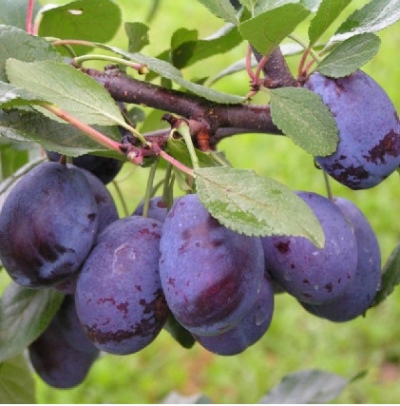
- Authors: Belarus
- Growth type: medium-sized
- Crown: sprawling, raised, medium density and rounded
- Fruit size: large
- Fruit weight, g: 60-70
- Fruit shape: elongated ovate
- Pulp (consistency): dense
- Pulp color : greenish yellow
- Bone size: medium
- Self-fertility: partially self-fertile
Plum Volat is excellent for meeting the needs of most gardeners. However, success is achieved only with a first-class approach to culture and competent agricultural technology. Attention should be paid to the botanical features of such a plum.
Description of the variety
Volat was created in Belarus. This is a common domestic culture that forms medium-sized trunks. Its crown is quite sprawling. It is raised, reaches medium density and has a rounded shape. The height of the trees reaches 2.5 m
Fruit characteristics
Large odnokostyanka Volata weigh 60-70 g. The shape of an elongated egg is typical for them. The bone is of medium size. It separates from the pulp without any problems.
Taste qualities
The official description emphasizes the firm flesh. It is colored greenish yellow. According to the description of the Volata monostable, they have a simple dessert taste. The juiciness of most specimens is noted.
Ripening and fruiting
You can count on getting a crop for 4 or 5 years of development. Average ripening times of plums are typical. The fruits will appear in mid-September. Further harvests will be removed annually.

Yield
The productivity level is pretty high. It is not characterized in the official description. However, in terms of 1 hectare in the garden, the harvest can be 2000-3000 kg. In a particular case, the effectiveness depends on the current weather and agricultural technology.
Self-fertility and the need for pollinators
Plum Volat is limited to self-fertile. It can grow without the help of other cultures. However, for a full-fledged harvest, it is necessary to plant nearby Hungarian Belarusian plums or Favorito del Sultano.
Growing and care
Farmers can use both vegetative and seed propagation methods. However, experts still consider vaccination to be the best way. Seeds are collected only from ripe fruits, devoid of any defects and violations. The bones must be stratified. To do this, they are kept at a temperature of 1 to 10 degrees for 150-180 days.
Plum root cuttings are recommended to be harvested in the fall. The thickness of such cuttings should be approximately 1.5 cm. It is not necessary to take too long - 15 cm is quite enough. Having cut such planting material, in the spring it is transplanted into sandy-peat soil. It is necessary to store cuttings in the cellars in winter.
Having planted a plant, it is necessary in the first season to feed it with humus or nitrogenous fertilizers. Mulching for the winter is done with sawdust or fallen leaves. Final landing readiness is achieved in the next season. Varietal seedlings should be approximately 1.5 m high and contain a formed rhizome.For planting seedlings, it is necessary to choose sod-podzolic soil or black soil; in some cases, the use of gray forest land is also permissible.
The holes should have a diameter of 0.7 m, and their optimal depth is from 0.4 to 0.5 m. You should immediately use a stake for a strong garter. A nutritional and maintenance mixture is placed on the bottom, including:
humus;
superphosphate;
potassium chloride;
ammonium nitrate;
coarse sand;
lime;
some amount of gravel.
The roots of the seedlings must be straightened very carefully. They are sprinkled on top with black earth to exclude the occurrence of a burn. It is preferable to choose a well-lit area that is not subject to drafts. If the Volat plum is planted next to tall trees, then you need to choose a place where the shadow cast by them does not fall. Organic fertilizers should be applied a maximum of 3 times a year.




Disease and pest resistance
Some danger for the Volat plum can be represented by clotterosporium disease. This infection attacks not only the flowers, but all the organs of the plant. The flow of gum appears in mechanically damaged areas. And also the risk may be associated with:
fruit rot (affecting the ripening crop);
marsupial disease;
gray rot;
fungal infections;
insects attacking plum plantings of other varieties.

Despite the fact that plum is considered more hardy than many fruit trees, it is not immune from diseases. It is attacked by viral, fungal and bacterial infections, and parasitic insects harm it. It is necessary to notice and recognize the signs of plum disease in time. They are easier to deal with and defeat early on. Well, in order to protect the garden tree from such a misfortune in the future, preventive procedures can be carried out.
Resistance to soil and climatic conditions
The variety is very winter-hardy. However, he can still suffer from the most severe frosts, especially in the seasons with little snow. Resistance to hot dry times is not described in the official description. At the same time, experts emphasize the need to take care of the plant in any unfavorable situation.



































































